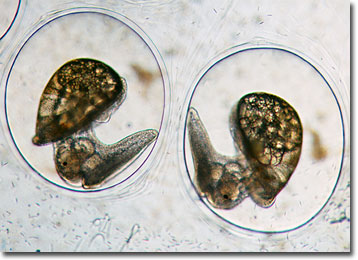Wim van Egmond
Snails in Eggs
Snails are well known gastropods that carry their homes on their backs and have a reputation for being slow moving. The organisms, however, have been extremely successful, accomplishing the rare feat of branching out into three different biospheres: freshwater, the oceans, and terra firma. Some tropical species can even be found in the trees, a seemingly unlikely place to look for these lowly creatures.

The term "gastropod" means “belly-footed,” a reference to the broad, tapered foot on which members of the class Gastropoda locomote with the help of mucus secretions. A large, diverse class that also contains the shell-less organisms commonly referred to as slugs, gastropods are customarily organized into three primary groups, namely the prosobranchs, the opisthobranchs, and the pulmonates. Of these groups, the prosobranchs secrete the most substantial shells and are provided with the best protection from predators and harsh environmental conditions since they feature a disclike operculum that fills the aperture to their homes when they are inside. In contrast, the opisthobranchs often have a reduced or absent shell and the pulmonates lack an operculum.
Humans have utilized snails since prehistoric times, although today some fast reproducing and introduced species can be considered pests. An early source of food, in some parts of the world snails, or escargot, continue to be considered a delicacy. In addition to their edibility, snails have been prized solely for their shells, which have been used by various societies throughout history as jewelry, as decorations, as a form of commercial exchange, and even as a badge of office. Perhaps snails are most important, however, for their integral role in the decomposition of plants and animals, which are modified into substances that can support new life.
BACK TO WIM VAN EGMOND GALLERY
